Abstract
Signal transducer and activator of transcription (STAT) proteins are latent cytoplasmic transcription factors that become activated in response to stimulation by various cytokines. Recently a new family of five structurally related proteins, called PIAS (Protein Inhibitor of Activated STAT) has been identified as potentially important downregulators of this pathway. Members of the PIAS family of STAT inhibitors may play a prominent role in the downregulation of STAT-mediated signaling processes. In this article we describe the isolation of the cDNA and expression of the gene for the murine homologue of the human STAT inhibitor family member PIASγ. The cDNA for mPIASγ encodes a protein of 507 amino acids that is highly homologous to the human protein and is expressed in the mouse as early as d 7.5 of gestation. In situ hybridizations of staged mouse embryos localized the transcript for the PIASγ gene to the limbs, neuroepithelium, and the inner root sheath of the hair follicle, suggesting a role in the development of these structures. Immunostaining studies with a polyclonal antibody (PAb) recognizing human PIASγ localized the protein in the hair follicle of human scalp hair and in monkey neuronal cells. Thus PIASγ exhibits a highly selective pattern of expression, suggesting that it modulates the response of cells to developmental cues.
Similar content being viewed by others
References
Amano S., Nishiyama T., and Burgeson R. E. (1999) A specific and sensitive ELISA for laminin 5. J. Immunol. Meth. 224, 161–169.
Bromberg J. F., Wrzeszczynska M. H., Devgan G., Zhao Y., Pestell R. G., Albanese C., and Darnell J. E. Jr. (1999) Stat3 as an oncogene. Cell 98, 295–303.
Chung C. D., Liao J., Liu B., Rao X., Jay P., Berta P., and Shuai K. (1997) Specific inhibition of Stat3 signal transduction by PIAS3. Science 278, 1803–1805.
Darnell J. E. Jr., Kerr I. M., and Stark G. R. (1994) Jak-Stat pathways and transcriptional activation in response to INFs and other extracellular signaling proteins. Science 264, 1415–1421.
Darnell J. E. Jr. (1997) Stats and gene regulation. Science 277, 1630–1635.
David M., Grimley P. M., Finbloom D. S., and Larner A. C. (1993) A nuclear tyrosine phosphatase downregulates interferon-induced gene expression. Mol. Cell. Biol. 13, 7515–7521.
De-Fraja C., Conti L., Magrassi L., Govoni S., and Cattaneo E. (1998) Members of the JAK/STAT proteins are expressed and regulated during development in the mammalian forebrain. J. Neurosci. Res. 54, 320–330.
Duncan S. A., Zhong Z., Wen Z., and Darnell J. E. Jr. (1997) STAT signaling is active during early mammalian development. Dev. Dyn. 208, 190–198.
Durbin J. E., Hackenmiller R., Simon M. C., and Levy D. E. (1996) Targeted disruption of the mouse Stat1 gene results in compromised innate immunity to viral disease. Cell 84, 443–450.
Endo T. A., Masuhara M., Yokouchi M., Suzuki R., Sakamoto H., Mitsui K., et al. (1997) A new protein containing an SH2 domain that inhibits JAK kinases. Nature 387, 921–924.
Filaroff E., Stern D. F., and Dotto G. P. (1990) Tyrosine phosphorylation is an early and specific event involved in keratinocyte differentiation. Mol. Cell. Biol. 10, 1164–1173.
Haque S. J., Flati V., Deb A., and Williams B. R. G. (1995) Roles of protein-tyrosine phosphatases in Stat1α-mediated cell signaling. J. Biol. Chem. 270, 25,709–25,714.
Haspel R. L., Salditt-Georgieff M., and Darnell J. E. Jr. (1996) The rapid inactivation of nuclear tyrosine phosphorylated Stat1 depends upon a protein tyrosine phosphatase. EMBO J. 15, 6262–6268.
Hou X. S., Melnick M. B., and Perrimon N. (1996) Marelle acts downstream of the Drosophila HOP/JAK kinase and encodes a protein similar to the mammalian STATs. Cell 84, 411–419.
Ihle J. N., Witthuhn B. A., Quelle F. W., Yamamoto K., and Silvennoinen O. (1995) Signaling through the hematopoietic cytokine receptors. Ann. Rev. Immunol. 113, 369–398.
Ikeda T., Takahashi H., Suzuki A., Ueno N., Yokose S., Yamaguchi A., and Yoshiki S. (1996) Cloning of rat type I receptor cDNA for bone morphogenetic protein-2 and bone morphogenetic protein-4 and the localization compared with that of the ligands. Dev. Dyn. 206, 318–329.
Kaplan M. H., Sun Y-L., Hoey T., and Grusby M. J. (1996a) Impaired IL-12 responses and enhanced development of Th2 cells in Stat4-deficient mice. Nature 282, 174–177.
Kaplan M. H., Schindler U., Smiley S. T., and Grusby M. J. (1996b) Stat6 is required for mediating responses to IL-4 and for the development of Th2 cells. Immunity 4, 313–319.
Kawata T., Shevchenko A., Fukuzawa M., Jermyn K. A., Totty N. F., Zhukovskaya N. V., et al. (1997) SH2 signaling in a lower eukaryote: a STAT protein that regulates stalk cell differentiation in dictyostelium. Cell 89, 909–916.
Kim T. K. and Maniatis T. (1996) Regulation of interferon-γ-activated STAT1 by the ubiquitin proteasome pathway. Science 273, 1717–1719.
Leaman D. W., Leung S., Li X., and Stark G. R. (1996) Regulation of STAT-dependant pathways by growth factors and cytokines. FASEB J. 10, 1578–1588.
Liu B., Liao J., Rao X., Kushner S. A., Chung C. D., Chang D. D., and Shuai K. (1998) Inhibition of Stat1-mediated gene activation by PIAS1. Proc. Natl. Acad. Sci. USA 95, 10,626–10,631.
Liu X., Quinn A. M., Chin Y. E., and Fu X. Y. (1999) STAT genes found in C. elegans. Science 285, 167a.
Liu X., Robinson G. W., Wagner K.-U., Garrett L., Wynshaw-Boris A., and Henninghausen L. (1997) Stat5a is mandatory for adult mammary gland development and lactogenesis. Genes Dev. 11, 179–186.
Mackay J. P. and Crossley M. (1998) Zinc fingers are sticking together. TIBS 23, 1–4.
Meraz M. A., White J. M., Sheehan K. C. F., Bach E. A., Rodig S. J., Dighe A. S., et al. (1996) Targeted disruption of the Stat1 gene in mice reveals unexpected physiologic specificity in the Jak-Stat signaling pathway. Cell 84, 431–442.
Mohr S. E. and Boswell R. E. (1999) Zimp encodes a homologue of mouse Miz1 and PIAS3 and is an essential gene in Drosophila melanogaster. Gene 229, 109–118.
Naka T., Narazaki M., Hirata M., Matsumoto T., Minamoto S., Aono A., et al. (1997) Structure and function of a new STAT-induced STAT inhibitor. Nature 387, 924–929.
Oates A. C., Wollberg P., Pratt S. J., Paw B. H., Johnson S. L., Ho R.K., et al. (1999) Zebrafish Stat3 is expressed in restricted tissues during embryogenesis and Stat1 rescues cytokine signaling in a STAT1-deficient human cell line. Dev. Dyn. 215, 352–370.
Planas A. M., Berruezo M., Justicia C., Barron S., and Ferrer I. (1997) Stat3 is present in the developing and adult rat cerebellum and participates in the formation of transcription complexes binding DNA at the sis-inducible element. J. Neurochem. 68, 1345–1351.
Riddle R., Johnson R., Laufer E., and Tabin C. (1993) Sonichedgehog mediates the polarizing activity of the ZPA. Cell 75, 1401–1416.
Schindler C. and Darnell J. E. Jr. (1995) Transcriptional responses to polypeptide ligands: the JAK-STAT pathway. Ann. Rev. Biochem. 64, 621–651.
Shuai K., Liao J., and Song M. M. (1996) Enhancement of antiproliferative activity of gamma interferon by the specific inhibition of tyrosine dephosphorylation of Stat1. Mol. Cell. Biol. 16, 4932–4941.
Starr R., Willson T. A., Viney E. M., Murray L. J. L., Rayner J. R., Jenkins B. J., et al. (1997) A family of cytokine-inducible inhibitors of signaling. Nature 387, 917–921.
Takeda K., Tanaka T., Shi W., Matsumoto M., Minami M., Kashiwamura S.-I., et al. (1996) Essential role of Stat6 in IL-4 signaling. Nature 380, 627–630.
Takeda K., Noguchi K., Shi W., Tanaka T., Matsumoto M., Yoshida N., et al. (1997) Targeted disruption of the mouse Stat3 gene leads to early embryonic lethality. Proc. Natl. Acad. Sci. USA 94, 3801–3804.
Thierfelder W. E., van Deursen J. M., Yamamoto K., Tripp R. A., Sarawar S. R., Carson R. T., et al. (1996) Requirement for Stat4 in interleukin-12-mediated responses of natural killer and T cell. Nature 383, 171–174.
Udy G. B., Towers R. P., Snell R. G., Wilkins R. J., Park S.-H., Ram P. A., et al. (1997) Requirement of Stat5b for sexual dimorphism of body growth rates and liver gene expression. Proc. Natl. Acad. Sci. 94, 7239–7244.
Valdez B. C., Henning D., Perlaky L., Busch R. K., and Busch H. (1997) Cloning and characterization of Gu/RH-II binding protein. Biochem. Biophys. Res. Comm. 234, 335–340.
Wu L., Wu H., Sangiorgi F., Wu N., Bell J.R., Lyons G., and Maxson R. (1997) Miz1, a novel zinc finger transcription factor that interacts with Msx2 and enhances its affinity for DNA. Mech. Dev. 65, 3–17.
Yan R., Small S., Desplan C., Dearolf C. R., and Darnell J. E. Jr. (1996) Identification of a Stat gene that functions in Drosophila development. Cell 84, 421–430.
Yang X., Chung D., and Cepko C. L. (1993) Molecular cloning of the murine JAK1 protein tyrosine kinase and its expression in the mouse central nervous system. J.Neurosci 13, 3006–3017.
Author information
Authors and Affiliations
Rights and permissions
About this article
Cite this article
Sturm, S., Koch, M. & White, F.A. Cloning and analysis of a murine PIAS family member, PIASγ, in developing skin and neurons. J Mol Neurosci 14, 107–121 (2000). https://doi.org/10.1385/JMN:14:1-2:107
Issue Date:
DOI: https://doi.org/10.1385/JMN:14:1-2:107




